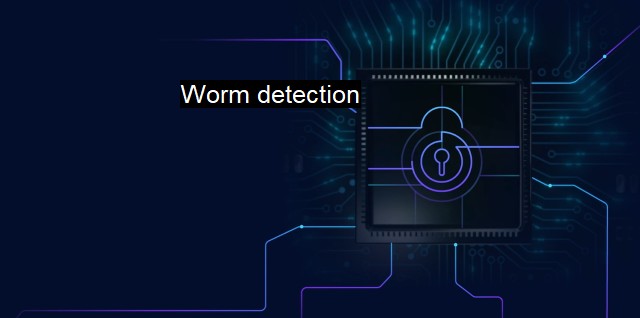What is Worm detection?
The Importance of Worm Detection in Modern Cybersecurity: Preventing Malware and Maintaining Network Safety
Worm detection is a crucial component in the broader field of cybersecurity and antivirus threat response. To understand what it means, it's necessary first to clarify what a "worm" is in this context. a worm is a kind of self-replicating malicious software or malware that can spread across networks without direct human involvement. Unlike viruses, which usually necessitate user interaction to spread and often directly corrupt or interrupt the active processes on an infected system, worms generally propagate themselves more subtly, using their host system's resources to create copies of themselves and infect the broader network.Worms leverage weaknesses in systems or networks to sneak in and start self-replicating. This self-propagation is rapid and extensive, often culminating in network-wide infections that happen in minimal time, making them particularly devastating. Their primary effects include system slowdown due to excessive network activity, data corruption or theft, and creating loopholes in system security for other malware or cyber attackers to exploit. Given their potential to wreak havoc to such an extent, detecting these rogue software elements in the system becomes understandably paramount.
Worm detection entails identifying the above-described malicious software elements in a network or computer system. Efficient worm detection depends on the capacity to recognize unusual activity or fluctuations in routine system procedures. These atypical activities may indicate a worm, given that such a piece of malware is known to function through unexpected system manipulations like unusual pattern in network traffic, unsolicited attempts to gain elevated system privileges, and excessive consumption of system resources. Therefore, effective worm detection is based on sensing such anomalies.
Worm detection involves techniques like signature-based worm detection and anomaly-based worm detection. Traditional signature-based detection approaches involve identifying the known code patterns or 'signatures' that mark specific types of worms, leveraging past intelligence regarding identifiable worm traits. these may not always be effective against worms with configurable payloads or polymorphic worms that change their signatures frequently. Therefore, signature-based detection works best when combined with other methods like heuristic and behavior-based detection.
Anomaly-based worm detection techniques monitor systems for behaviors that deviate from the norm, identifying possible threats based on unusual activity. Ideally, they can catch worms in operation before significant damage is done, making them a key layer of protection. Still, these methods may have a higher rate of false positives, perceiving legitimate system operations as potential threats.
Proactive steps, such as implementing stringent security protocols, maintaining regular system updates, and promoting worker cybersecurity awareness, are also decisive in thwarting worm infection. Since worms capitalize on system vulnerabilities, patched software and an overall secure network can considerably minimize a worm's destructive potential.
Worm detection tools, often built into antivirus programs, are vital and continuously evolving instruments in global cybersecurity ecology. Given the growing sophistication of worm attacks, developers must ensure these tools stay ahead of the curve in this constant cat-and-mouse game. Development in AI and machine learning have the potential to drastically improve worm detection, through intelligent, automated systems which can recognize and adapt to new threats more quickly and comprehensively than ever before.
Individual security measure, strong company-wide cyber hygiene, alongside standard antivirus and antimalware solutions with robust worm detection capabilities, contribute to creating an empowered front line in reality of the dynamic threat that worms signify to cybersecurity. Particularly, worm detection consolidates our ability to address the insidiousness of "silent" threats, ever present and, if unchecked, potentially destructive in the landscape of our increasingly digital world.

Worm detection FAQs
What is worm detection, and why is it important for cybersecurity?
Worm detection is an essential component of antivirus software that helps identify and prevent worm attacks on systems. Worms are self-replicating malware that can spread across networks, causing significant damage to systems and data. Worm detection helps detect and remove worms before they can cause serious harm.How does worm detection work in antivirus software?
Worm detection in antivirus software involves using a combination of signature-based and behavior-based detection techniques. Signature-based detection looks for known worm signatures in code or network traffic, while behavior-based detection focuses on identifying anomalous behaviors that could indicate a worm attack. Together, these techniques help identify and remove worms from systems.What are some common signs of a worm attack that antivirus software with worm detection can help identify?
Some common signs of a worm attack that antivirus software with worm detection can help identify include unusually slow system performance, network congestion, and unusual network activity or traffic patterns. Additionally, antivirus software may detect and quarantine suspicious files or processes that could be associated with worm attacks.Can antivirus software with worm detection prevent all worm attacks?
While antivirus software with worm detection is an effective way to identify and prevent many worm attacks, it's not foolproof. Some advanced worm attacks can evade detection, particularly if they use new or sophisticated techniques. It's important to keep antivirus software up-to-date and to practice good cybersecurity hygiene, such as avoiding suspicious links or downloading files from unknown sources, to minimize the risk of a worm attack.| | A | | | B | | | C | | | D | | | E | | | F | | | G | | | H | | | I | | | J | | | K | | | L | | | M | |
| | N | | | O | | | P | | | Q | | | R | | | S | | | T | | | U | | | V | | | W | | | X | | | Y | | | Z | |
| | 1 | | | 2 | | | 3 | | | 4 | | | 7 | | | 8 | | |||||||